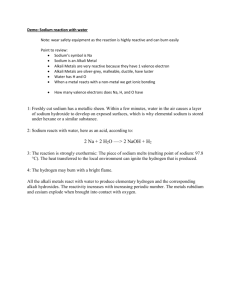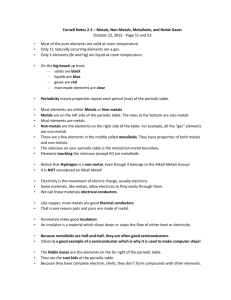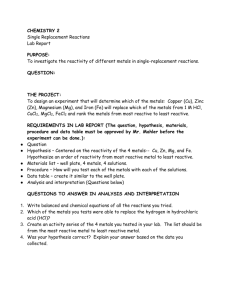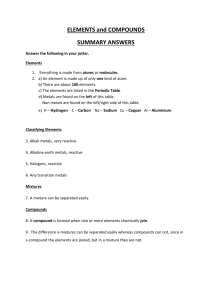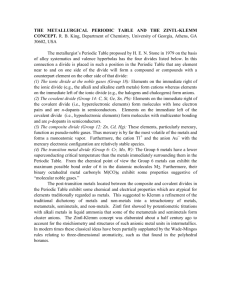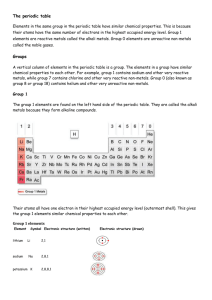THE PERIODIC TABLE
advertisement
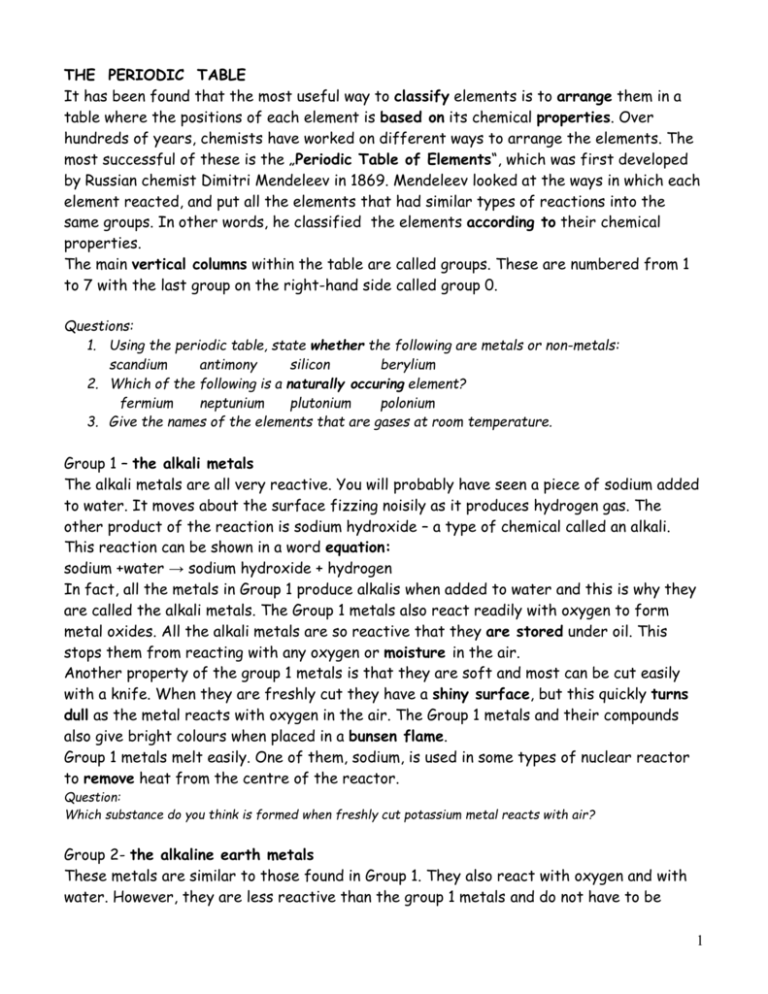
THE PERIODIC TABLE It has been found that the most useful way to classify elements is to arrange them in a table where the positions of each element is based on its chemical properties. Over hundreds of years, chemists have worked on different ways to arrange the elements. The most successful of these is the „Periodic Table of Elements“, which was first developed by Russian chemist Dimitri Mendeleev in 1869. Mendeleev looked at the ways in which each element reacted, and put all the elements that had similar types of reactions into the same groups. In other words, he classified the elements according to their chemical properties. The main vertical columns within the table are called groups. These are numbered from 1 to 7 with the last group on the right-hand side called group 0. Questions: 1. Using the periodic table, state whether the following are metals or non-metals: scandium antimony silicon berylium 2. Which of the following is a naturally occuring element? fermium neptunium plutonium polonium 3. Give the names of the elements that are gases at room temperature. Group 1 – the alkali metals The alkali metals are all very reactive. You will probably have seen a piece of sodium added to water. It moves about the surface fizzing noisily as it produces hydrogen gas. The other product of the reaction is sodium hydroxide – a type of chemical called an alkali. This reaction can be shown in a word equation: sodium +water → sodium hydroxide + hydrogen In fact, all the metals in Group 1 produce alkalis when added to water and this is why they are called the alkali metals. The Group 1 metals also react readily with oxygen to form metal oxides. All the alkali metals are so reactive that they are stored under oil. This stops them from reacting with any oxygen or moisture in the air. Another property of the group 1 metals is that they are soft and most can be cut easily with a knife. When they are freshly cut they have a shiny surface, but this quickly turns dull as the metal reacts with oxygen in the air. The Group 1 metals and their compounds also give bright colours when placed in a bunsen flame. Group 1 metals melt easily. One of them, sodium, is used in some types of nuclear reactor to remove heat from the centre of the reactor. Question: Which substance do you think is formed when freshly cut potassium metal reacts with air? Group 2- the alkaline earth metals These metals are similar to those found in Group 1. They also react with oxygen and with water. However, they are less reactive than the group 1 metals and do not have to be 1 stored under oil. Group 2 metals are also harder than the alkali metals and cannot be cut easily with a knife. Magnesium is used to make special alloys for car wheels. Powdered magnesium and barium are both used in fireworks – they give off a shower of gright lights when they burn. Group 7 – the halogens These are all non-metals and they are all very reactive. For example, the gas chlorine reacts violently with sodium to produce sodium chloride: sodium + chlorine → sodium chloride As you go down the group, the physical states of the elements change; chlorine and fluorine are gases, bromine is a liquid and iodine is a solid. Chlorine is used in swimming pools and in disinfectants because it kills germs. Fluoride compounds are added to toothpaste to help prevent tooth decay. Group 0 – the noble gases These gases are the least reactive elements of all. They are called „noble“ to suggest that they do not join up easily with other elements. All the noble gases are found in very small amounts in the air. Helium is lighter than air and so is used in airships and toy balloons. Neon is used in advertising signs because it glows bright red when an electric current is passed through it. The transition metals These metals are in a block in the centre of the periodic table. They have many important uses. E.g., chromium and nickel are added to steel to make stainless steel. Many catalysts are transition metals, for example the ones used in catalytic converters in cars. Questions: 1. Which of the following are transition metals? Ba Pb Pt La 2. a) silicon b) potassium c) iodine d) barium e) lead f) helium Which metal element and non-metal element are in the same group of the periodic table? Which element gives a green flame colour? Which element was discovered most recently? 3. a) mercury b) neon c) calcium Which element is an alkali metal? Which element is a very unreactive gas? d) bromine e) sodium f) silver 4.Find and underline all examples of passive voice ( is used,...) adjective comparison (harder, ...) 2

